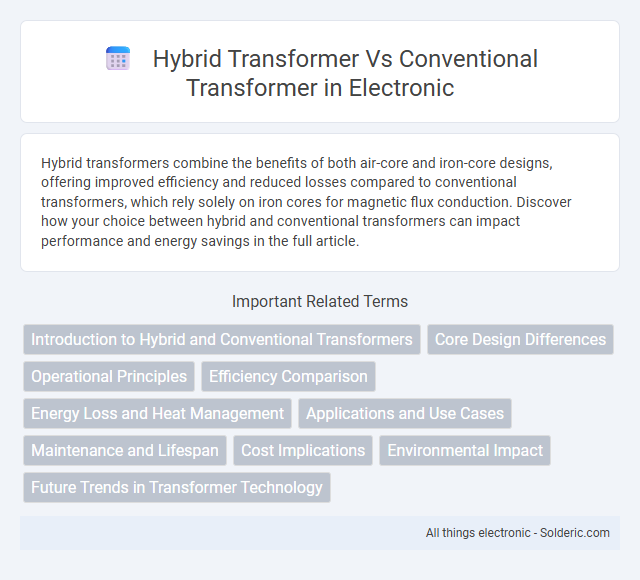Hybrid transformers combine the benefits of both air-core and iron-core designs, offering improved efficiency and reduced losses compared to conventional transformers, which rely solely on iron cores for magnetic flux conduction. Discover how your choice between hybrid and conventional transformers can impact performance and energy savings in the full article.
Comparison Table
| Feature | Hybrid Transformer | Conventional Transformer |
|---|---|---|
| Core Technology | Combines transformer and advanced electronic components | Purely electromagnetic-based design |
| Efficiency | Higher efficiency due to reduced losses and improved cooling | Moderate efficiency limited by core and copper losses |
| Size & Weight | More compact and lighter with integrated design | Bulkier and heavier due to traditional core and coil setup |
| Thermal Performance | Enhanced thermal management with advanced materials | Standard thermal management with conventional insulation |
| Applications | Used in modern power grids, renewable energy, and smart grids | Widely used in traditional power distribution and industrial machines |
| Cost | Higher initial cost but lower operational costs | Lower initial cost but higher maintenance expenses |
| Reliability | Improved reliability due to advanced materials and design | Proven reliability over decades in various conditions |
Introduction to Hybrid and Conventional Transformers
Conventional transformers operate on electromagnetic induction principles, primarily consisting of laminated iron cores and copper windings to transfer electrical energy between circuits. Hybrid transformers combine features of conventional transformers with power electronic components, enabling improved efficiency, reduced size, and enhanced voltage regulation. These hybrid models integrate magnetic and semiconductor technologies to address limitations of traditional transformers in modern power systems.
Core Design Differences
Hybrid transformers integrate both core-type and shell-type design elements, featuring a laminated core that combines the magnetic flux paths to optimize efficiency and reduce losses. Conventional transformers typically use a single core design, either core-type with windings around limbs or shell-type enclosing the core, which can limit flexibility in handling varying load conditions. Your choice of transformer impacts performance based on these core design differences, influencing factors such as size, cooling, and electromagnetic compatibility.
Operational Principles
Hybrid transformers combine solid-state electronics with magnetic cores to regulate voltage more efficiently, allowing for faster response times and improved energy conversion. Conventional transformers rely solely on electromagnetic induction principles using coils and laminated steel cores to transfer electrical energy between circuits with fixed voltage ratios. The hybrid design enhances operational flexibility and reduces losses by integrating power electronics control, unlike traditional transformers limited to passive voltage transformation.
Efficiency Comparison
Hybrid transformers deliver higher efficiency compared to conventional transformers by combining the advantages of solid-state and magnetic core technologies, reducing energy losses and heat generation during operation. Your power system benefits from lower operational costs and improved performance due to enhanced load handling and minimized core hysteresis. Efficiency gains typically result in energy savings of up to 15% over traditional transformer designs, making hybrids ideal for modern electrical applications.
Energy Loss and Heat Management
Hybrid transformers reduce energy loss by combining the high efficiency of solid-state components with the reliability of conventional magnetic cores, leading to significantly lower I2R losses compared to traditional transformers. Improved heat management in hybrid transformers is achieved through advanced cooling techniques such as liquid or forced air cooling integrated with semiconductor devices, which dissipate heat more effectively than conventional oil-immersed designs. Your energy costs decrease and equipment lifespan extends thanks to these innovations in minimizing heat generation and enhancing thermal regulation.
Applications and Use Cases
Hybrid transformers are extensively used in renewable energy systems and smart grids, combining the benefits of conventional transformers with advanced features like voltage regulation and fault detection, enhancing grid stability and efficiency. Conventional transformers dominate in traditional power distribution and industrial applications due to their reliability and simplicity in stepping voltage levels. Your choice depends on the need for advanced monitoring and control in modern energy setups versus straightforward, cost-effective power transmission.
Maintenance and Lifespan
Hybrid transformers typically exhibit lower maintenance requirements due to their advanced cooling systems and improved insulation materials, which reduce the risk of overheating and insulation degradation. Conventional transformers often demand more frequent inspections and oil replacements to prevent failures caused by thermal and mechanical stresses. The longer lifespan of hybrid transformers is attributed to their enhanced efficiency and reduced operational wear, offering extended service intervals compared to traditional models.
Cost Implications
Hybrid transformers often entail higher initial costs due to advanced materials and design complexity, but they can deliver improved efficiency and reduced energy losses compared to conventional transformers. Over time, the operational savings and lower maintenance expenses of hybrid models may offset the upfront investment, resulting in better total cost of ownership. Your choice between hybrid and conventional transformers should weigh both the immediate purchase price and the long-term financial benefits associated with energy savings and reliability.
Environmental Impact
Hybrid transformers reduce environmental impact by combining the efficiency of solid-state components with traditional magnetic cores, resulting in lower energy losses and reduced greenhouse gas emissions compared to conventional transformers. They typically use biodegradable or less harmful insulating materials, minimizing soil and water contamination risks often associated with mineral oil-filled conventional transformers. Enhanced operational efficiency and reduced cooling requirements in hybrid transformers further decrease carbon footprints and resource consumption across their lifecycle.
Future Trends in Transformer Technology
Hybrid transformers integrate solid-state electronics with conventional magnetic cores, enabling higher efficiency and faster response times compared to traditional transformers. Future trends in transformer technology emphasize improved grid resilience, increased use of smart sensors, and advancements in materials like amorphous steel to reduce energy losses. Research continues on embedding AI-driven control systems within hybrid transformers to optimize load management and predictive maintenance in smart grids.
Hybrid transformer vs conventional transformer Infographic

 solderic.com
solderic.com